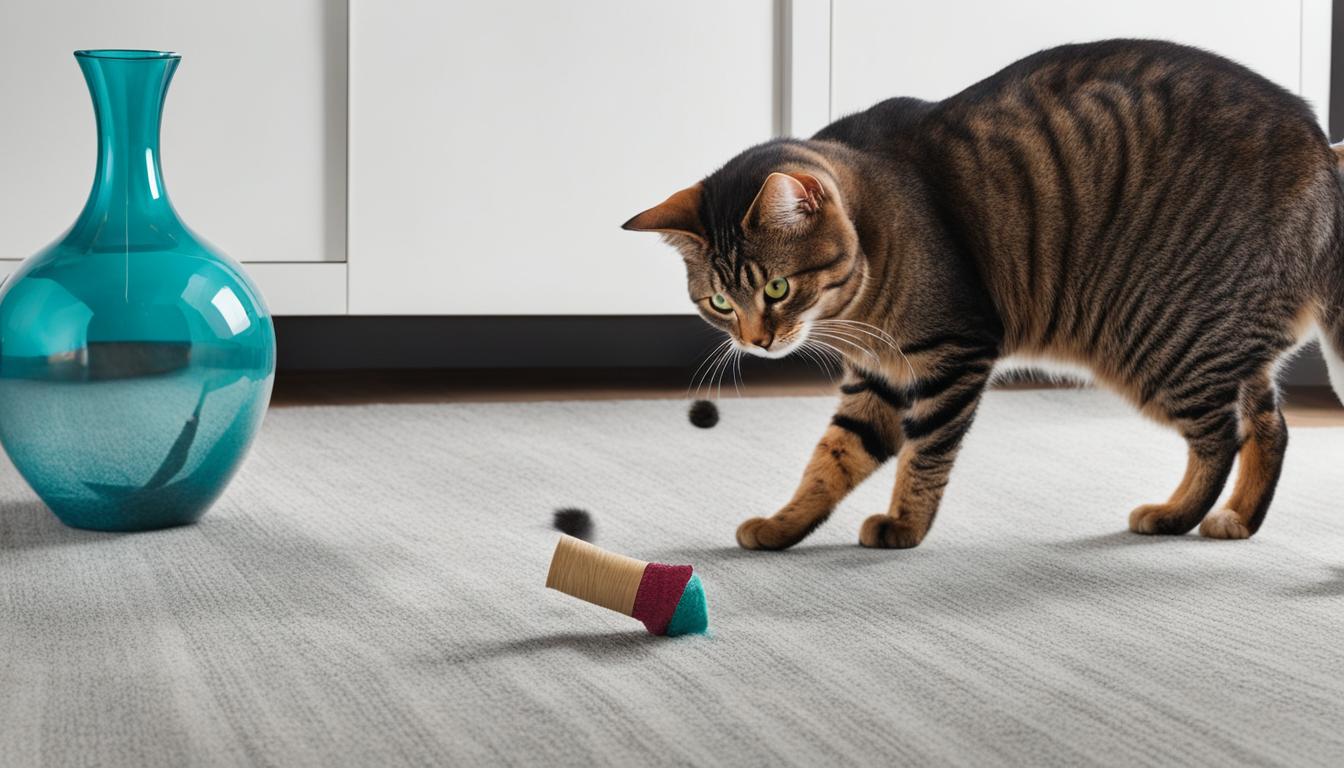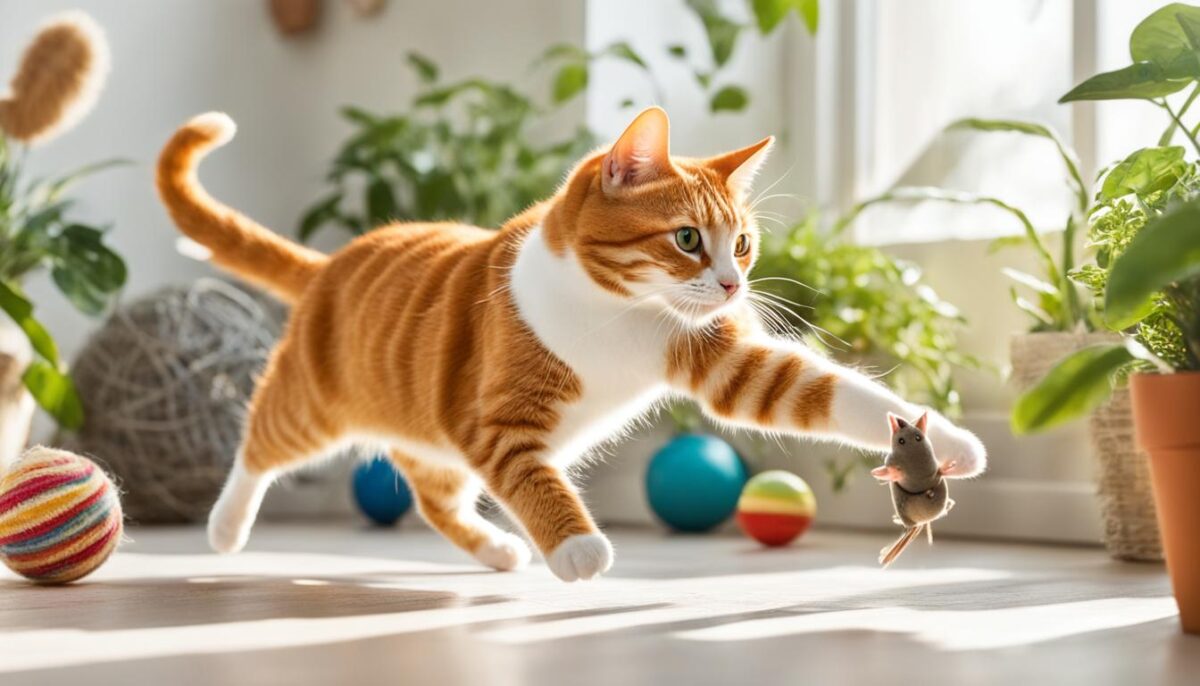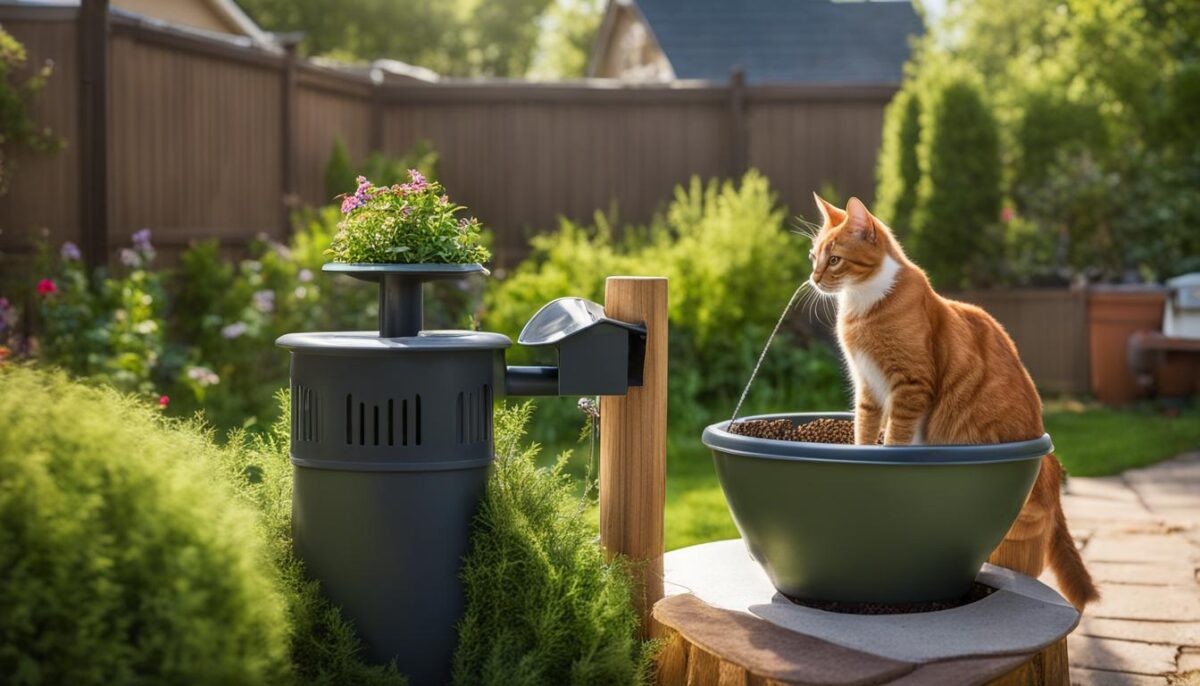Do you want to stop cat scratching at home? Or prevent jumping on counters? Understanding cats and teaching them good habits might seem hard, but it’s not! To help your pet understand where it’s OK to climb and scratch, you’ll need patience and some tips on cat discipline and feline behavior modification. It’s about being kind and smart, not about being tough.
Imagine you’re a cat. You love to climb and see everything from up high. That’s why kitties jump on counters. They also need to scratch to keep their claws sharp. Remember, cats don’t know they’re being bad when they do these things. They just do what feels natural. Your job is to teach them the right places for cat things and use gentle ways to tell them no when they make mistakes.
Key Takeaways
- Remember, cats like high places, so give them safe spots to climb.
- Get a scratching post to keep your kitty’s claws away from the couch.
- Play is important, so have toys ready for hunting games.
- Stay calm and never scare your cat to teach them.
- Loud or sticky things can keep cats off where they shouldn’t be.
- Always say “good job!” when they scratch or climb in the right places.
Understanding Your Cat’s Instincts
Do you ever watch your cat and wonder why they do the things they do? It’s all about feline instincts. These are the natural habits that cats have. Just like you have your own ways of having fun, cats do too. They explore their environment, climb to tall spots, scratch on surfaces, and play games to stay sharp and mark their areas. Let’s dive into why these natural cat behaviors are important for your furry friend.
When cats jump to high places, they are not just doing it for fun. They feel safe up there, where they can see everything around them. This is part of their cat environment exploration. Cats also scratch things to keep their claws neat and to tell everyone, “This is my place!” And when they play, they pretend they’re hunting. It’s like a game for them to practice being sneaky and quick!
Cats are curious by nature, and their instincts are a big part of who they are. Giving your cat the right spots to perch, scratch, and play is the key to a happy and healthy cat life.
- **High places:** Let your cat climb and look around. A good spot makes them feel safe and happy.
- **Scratching:** It’s not just for fun. Scratching keeps cat claws sharp. A scratching post can save your furniture!
- **Playing:** Cats love to chase and pounce. Toys help them use their energy and be great hunters.
If you give your cat what they naturally need, you’ll notice they’re less likely to do things you don’t like. Instead of getting into trouble, they’ll be having fun in the ways that are best for them. And you’ll be happy too because your house and furniture will be safe from cat adventures!
Proactive Measures to Redirect Unwanted Behavior
Let’s learn how to keep your fuzzy friend happy without them scratching up the couch or jumping on places they shouldn’t! With some smart changes to your home, you can help your cat be their best self. It’s like creating a kitty playground that’s just for them!
Providing Appropriate Scratching Surfaces
Your cat loves to claw and scratch, it’s a big part of being a cat! By setting up scratching posts or cool kitty condos near where they sleep, they’ll have a perfect place to stretch and scratch when they wake up. Plus, putting not-so-fun things like sticky tape on furniture can keep their claws away, saving your sofa from those little daggers!
Creating Engaging Playtime
Cats are curious and need to play! Think about giving your kitty interactive cat toys like a mouse they can chase or a feather wand. Toys like these will give them all the action they crave and keep their paws away from things they shouldn’t touch. It’s playtime that’s fun for them and good for your home!
Designating High Perches and Rest Areas
Cats love to climb and look out at the world. By adding cat towers or window sill beds in your home, your cat gets to explore high spots and watch the world safely inside. This means they’re less likely to turn your counters or bookshelves into their personal jungle gym!
- Choose a tall scratching post.
- Buy toys that move and keep your cat guessing.
- Create a window view with a comfy perch.
By trying these tips, you can help your cat feel at home and save your furniture at the same time!
How to Stop Bad Cat Behavior
Trying to change cat behavior can be tough. But don’t worry, you can teach your furry friend to behave better with some smart moves.
- Redirecting cat behavior: If your cat loves jumping on counters, try laying down foil or paper that makes noise. Cats do not like strange sounds and will stay away.
- Positive reinforcement: When your cat uses the scratching post instead of the couch, give them a yummy treat or some cuddle time. This will make them want to do it again!
- Cat behavior training: Sometimes, cats play too rough. If they do, say “ouch” really loud to surprise them and then walk away. This teaches them to be gentle.
Remember: Every cat needs their own space. Give them a cozy spot with a view to climb and watch the birds, not your kitchen counters!
| Behavior | What To Do | What Not To Do |
|---|---|---|
| Climbing counters | Set up a place by the window just for them | Don’t yell or spray water |
| Playing too rough | Say “ouch” and ignore them for a bit | Don’t hit or chase them |
| Not using litter box | Check with the vet for health issues | Don’t punish – there might be a good reason! |
If you have more than one kitty, be sure all have their own litter box. Keep them clean and in the right spot so each cat feels happy and safe.
Alternatives to Physical Punishment
As a pet owner, you love your furry friend and want them to be happy and well-behaved. Sometimes, cats do things that you might not like, such as scratching the couch or jumping on the kitchen table. But you know that being tough with them is not the answer. It is important to find smart ways to teach your cat without scaring them. This is where cat disciplinary tools and non-physical discipline strategies come into play.
Remote Correction Techniques
Imagine you have a little remote control that helps you guide your cat away from places they shouldn’t be. That’s a bit like how remote correction works. Instead of telling your cat ‘no’ with a loud voice or a spray bottle, you can use tools that are kind and gentle. Non-physical discipline is all about making the wrong places seem boring or a little uncomfortable, so your cat decides not to go there all on their own.
For example, motion activated air canisters can puff out harmless air when your cat jumps onto the counter. It’s just a surprise, not scary or hurtful. Your cat then thinks, “Huh, maybe I’ll stay off the counter.” It becomes their choice, guided by your smart planning.
Environmental Deterrents and Their Uses
Cats are smart and they can learn where they should and shouldn’t be in your home. Cat disciplinary tools can include things you put in places you want your cat to avoid. A strip of double-sided tape on your couch or aluminum foil on your counters feels weird to their paws. They don’t like the stickiness or the sound, so they’ll decide that’s not the place for them.
- Double-sided tape
- Aluminum foil on counters
- Citrus or eucalyptus oil on a cloth in no-go zones
These tricks help your cat learn the house rules without needing you to tell them off or be stern. You can also use smells that cats don’t like. Cats aren’t big fans of citrus, so putting a little lemon scent in places they should stay away from can do wonders. It’s their nose telling them “let’s not go here” instead of you.
Remember, using these methods is all about guiding your cat gently and keeping them happy. You’re not just stopping them from being where you don’t want them—you’re also helping them understand your home in a way that keeps them safe and loved.
Dealing with Specific Issues: Jumping and Scratching
Is your furry friend jumping onto places like kitchen counters? One neat trick is to make these spots boring. Keep yummy foods or interesting-smelling things off the counters. Instead, get your cat a fun cat tower. Place it by a window so they can have a good view while staying off your workspaces. Remember to keep your cat out of the kitchen while you’re cooking, to keep them safe and not stressed.
Does your cat like scratching your favorite sofa or chair? This might mean they’re feeling stressed or just want to play. You can help them by getting them a sturdy scratching post. This gives them a special spot to scratch so they leave your furniture alone. Spend some time with them, too, so they feel loved and happy. Cat discipline techniques are about being patient and never hurting your cat. Always be kind and they will learn.
With a little bit of time and some understanding, cat jumping issues and furniture scratching can be managed without fuss. Give your cat places they are allowed to climb and scratch, and you both will be happier. Remember, it’s all about being clever and caring in the way you guide your cat’s behavior.
FAQ
How can I stop my cat from scratching my furniture?
To prevent your cat from scratching furniture, provide them with scratching posts or kitty condos where they can stretch and scratch, especially near where they sleep. You can also make furniture less appealing by using double-sided tape or aluminum foil, and remember to praise your cat when they use appropriate scratching surfaces.
What can I do to keep my cat from jumping on my kitchen counters?
To discourage your cat from jumping on counters, keep the surfaces clean of food and any tempting items. Offer alternative climbing options like cat towers, especially near windows, and consider using noise-making materials or motion-activated air sprays as deterrents. Make sure to keep your cat occupied with other activities during times you are using the kitchen.
How should I discipline my cat without scaring them?
Focus on redirection and positive reinforcement rather than physical punishment. Use remote correction techniques like deterrents that make noise or emit a puff of air. Introduce unpleasant textures or smells in areas you want to keep off-limits. Always praise good behavior with treats or attention, and check with a vet if abnormal behavior persists, as it may indicate stress or health issues.
Why does my cat scratch, and how can I manage it?
Cats scratch to keep their claws sharp and to mark their territory. To manage scratching behavior, provide plenty of appropriate surfaces like scratching posts or pads. Place these near areas they frequent, such as their bed or favorite hangouts. If your cat scratches furniture, cover those spots with materials that deter scratching and lead your cat to the acceptable scratching area.
Are there any effective non-physical cat disciplinary tools?
Yes, non-physical tools such as double-sided tapes, noisy materials, and scent deterrents like citrus or eucalyptus oil can be effective. There are also automatic devices like motion-activated sprays that can help train your cat to avoid certain areas without physical intervention. Employing environmental deterrents along with positive reinforcement can help guide your cat’s behavior.
My cat keeps jumping on higher surfaces. How can I redirect this behavior?
Cats instinctively seek high vantage points. To redirect this desire, provide your cat with high perches and rest areas such as cat trees or window perches where they can observe their environment. Ensuring that these areas are more appealing than forbidden surfaces will naturally draw your cat to use them instead.
How can I create engaging playtime to prevent my cat from misbehaving?
Engage your cat with interactive toys that stimulate their hunting instincts, such as wand toys, laser pointers, or balls they can chase. Establish routine play sessions to keep them mentally and physically stimulated. The more involved and entertained they are, the less likely they are to engage in unwanted behaviors out of boredom or excess energy.


